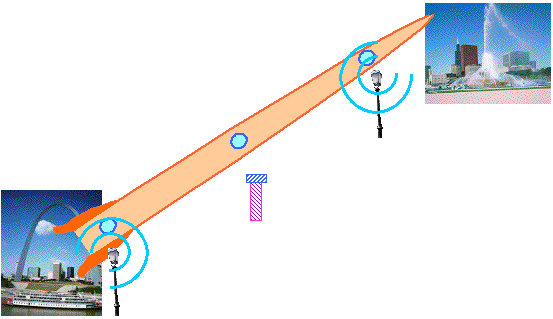

Simultaneity

How do we know if two "events" occur at the same time?
How do we tell if two "events" are simultaneous?
Will observers in moving reference frames agree that two events are simultaneous?
For the speeds that we normally encounter in our everyday lives, the relativistic effects we are studying now are too small to be seen readily. They can be measured--and have been measured--with very accurate equipment.
Even at supersonic speeds
or orbital speeds
the results are very, very small. But all these speeds are very, very small compared to the speed of light. These results become noticeable and interesting when we have speeds that are 90% the speed of light--or 95% the speed of light or 98% the speed of light!
Now, back to our question,
How do we know if two "events" occur at the same time? How do we tell if two "events" are simultaneous?
Will observers in moving reference frames agree that two events are simultaneous?
Consider two streetlights, on the edges of St Louis and of Chicago
.
They both go on at exactly 8:00. Who observes that? How is that observed? What would a moving observer see? That is, will a moving observer find these "events" to be simultaneous? Or, which streetlight will the moving observer find is turned on first?
In the Earth reference frame, we can station two observers--one near each streetlight and let them use their synchronized watches to determine the exact time "their" streetlight is turned on. Another, more elaborate but more useful, method would be to station a single observer on an observation tower exactly midway between the two streetlights. If this "midway observer" finds light from the two streetlights reaches her at the same time, then the two streetlights were turned on at the same time. The two events are simultaneous.
Now also consider a very long alien space ship that passes by St Louis and Chicago as we are making our Earth-based observations, somewhat like the illustration here. Observers at the front and rear of the spaceship see their respective streetlights come on. If light from these streetlights reaches an observer midway between these observers at the same time, the moving observers will conclude that the two lights were, indeed, turned on at the same time.
Remember, the space ship is moving. Let's see what happens, . . .

The first photons from the two streetlights do, indeed, reach the Earth-bound, "midway observer" at the same time, so she concludes that the two events were simultaneous. That is, in the Earth reference frame, the two streetlights were turned on at the same time.
However, the "midway observer" in the moving reference frame encounters the first photos from Chicago some time before encountering the first photons from St Louis. He concludes that the streetlight in Chicago was turned on before the streetlight in St Louis; the two events were not simultaneous. That is, in the moving reference frame, the clocks and watches in Chicago are seen to have times that are ahead of the clocks and watches in St Louis.
This explanation shows that simultaneity is relative. But we shall need some mathematical relationships to provide details like how much of a difference is observed. In our example, with the two cities 500 km apart, for a spaceship traveling at 90% the speed of light, a difference of about 3 ms is to be expected.
This effect is symmetric. For observers moving with the spaceship, all the on-board clocks are carefully synchronized. But when viewed from Earth, the clocks on the front part of the spaceship are late. For both cases, the clocks on the leading edge of the moving reference frame are observed to be late.
By now you may be thinking, "all right, so that's what is measured; but what's really happening?" But you can not ask that. Physics is an observational science. We are stuck with operational definitions and actual measurements. What we measure is all we have; it is all we can talk about in Physics. This is not to imply that things like love and beauty do not exist or are not important. They're just not Physics.
The animation in Simultaneity - II may require some time to download.

(c) Doug Davis, 2003; all rights reserved